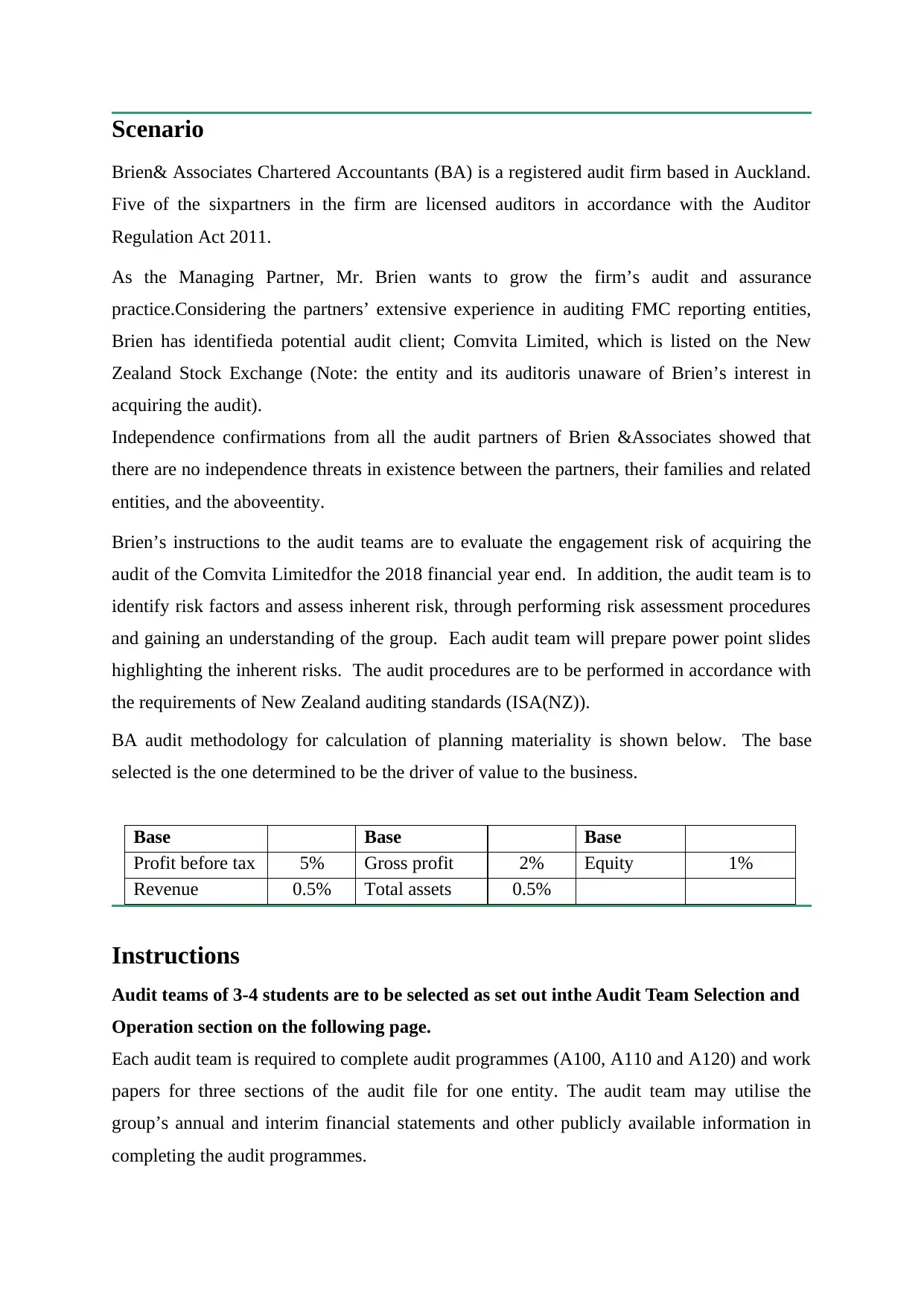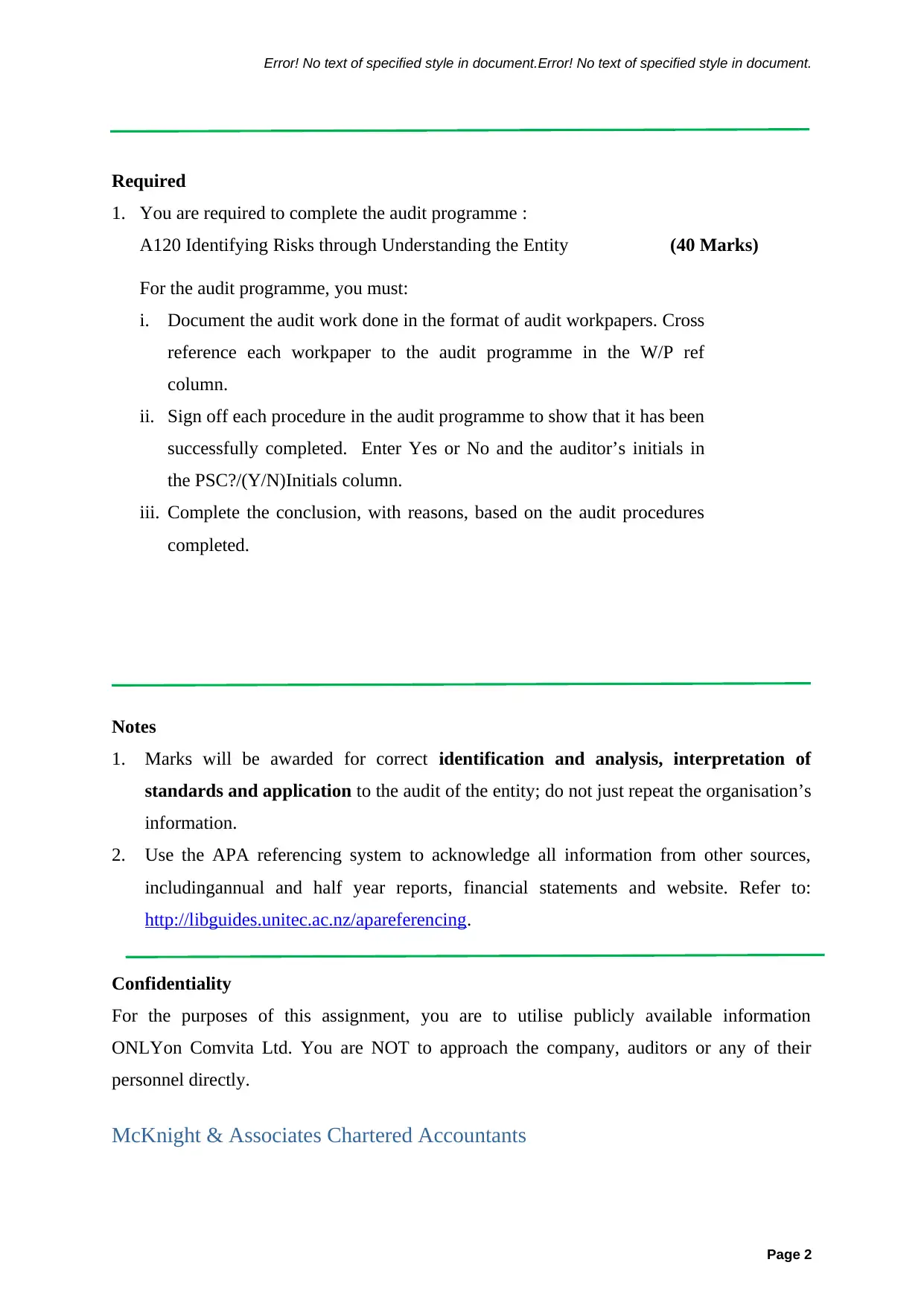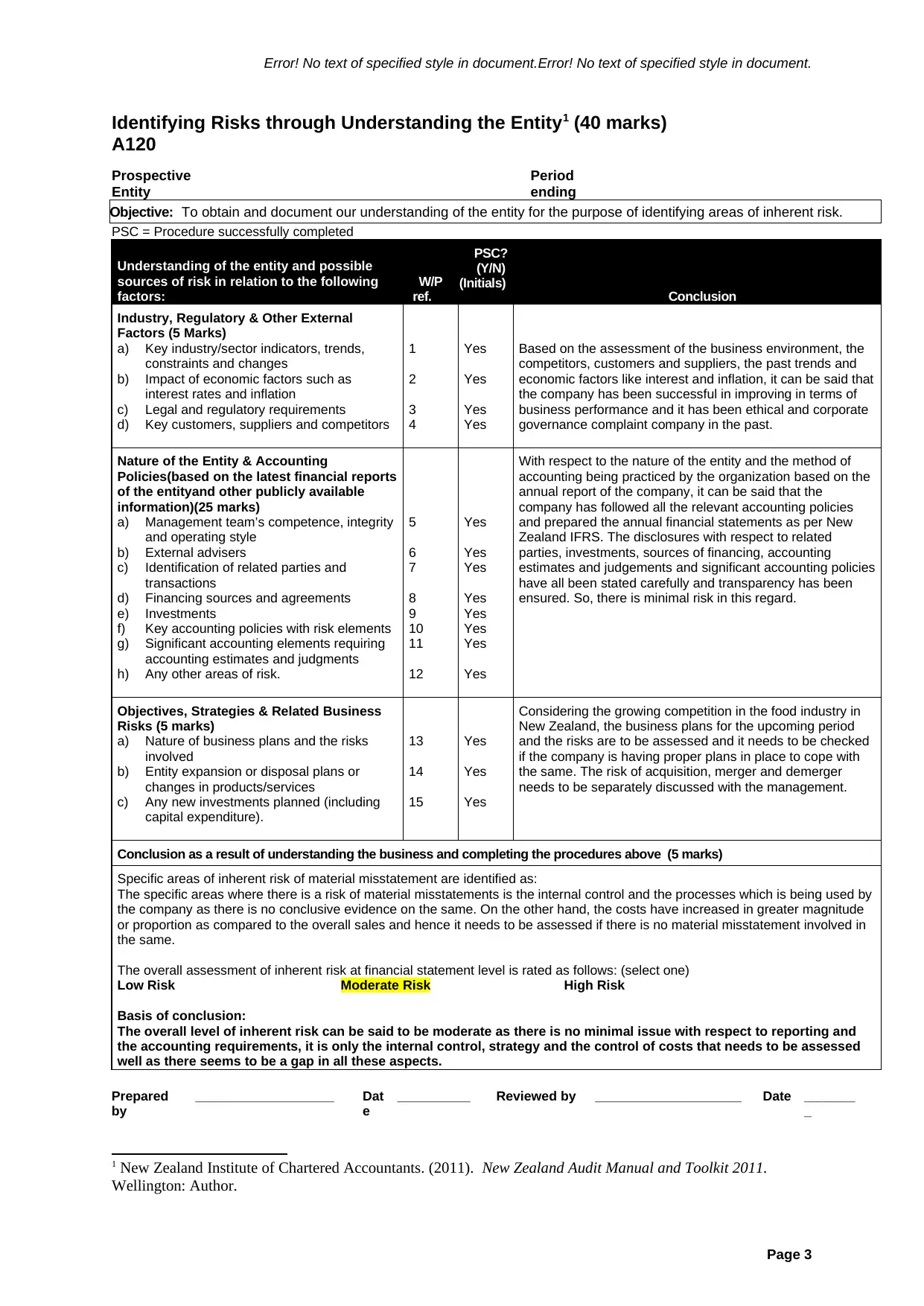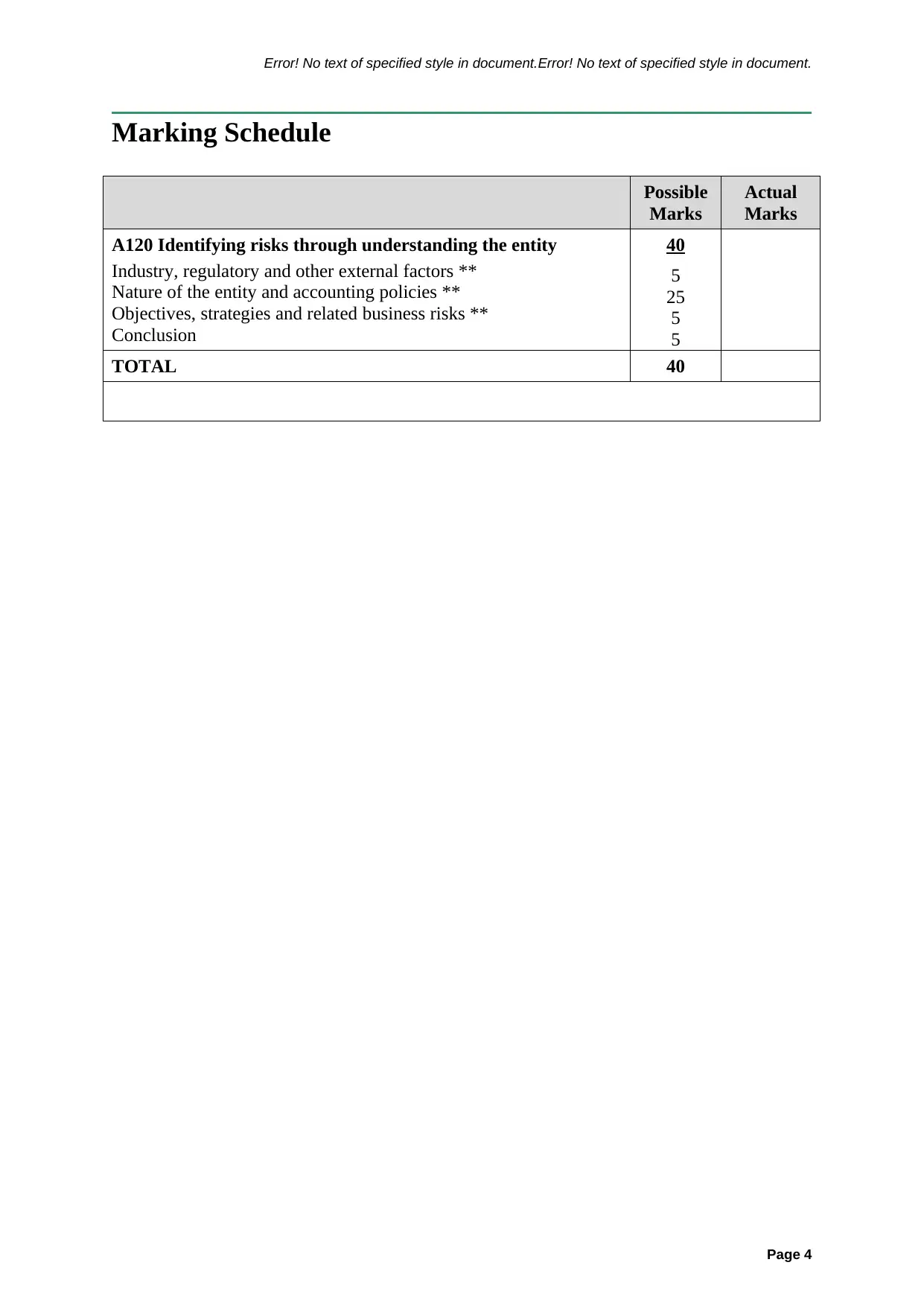A120 Audit Programme: Identifying Risks in Comvita Limited Audit 2018
VerifiedAdded on 2023/06/03
|4
|1414
|165
Practical Assignment
AI Summary
This assignment solution focuses on identifying risks through understanding the entity, Comvita Limited, as part of an audit program (A120). The audit team evaluates industry factors, regulatory requirements, the nature of the entity, accounting policies, objectives, strategies, and related business risks. The conclusion assesses inherent risks, identifying areas of potential material misstatement related to internal controls and cost management. The overall inherent risk is rated as moderate, emphasizing the need for further assessment of internal controls, strategy, and cost control measures. This solution, contributed by a student and available on Desklib, provides valuable insights into practical audit risk assessment.

Scenario
Brien& Associates Chartered Accountants (BA) is a registered audit firm based in Auckland.
Five of the sixpartners in the firm are licensed auditors in accordance with the Auditor
Regulation Act 2011.
As the Managing Partner, Mr. Brien wants to grow the firm’s audit and assurance
practice.Considering the partners’ extensive experience in auditing FMC reporting entities,
Brien has identifieda potential audit client; Comvita Limited, which is listed on the New
Zealand Stock Exchange (Note: the entity and its auditoris unaware of Brien’s interest in
acquiring the audit).
Independence confirmations from all the audit partners of Brien &Associates showed that
there are no independence threats in existence between the partners, their families and related
entities, and the aboveentity.
Brien’s instructions to the audit teams are to evaluate the engagement risk of acquiring the
audit of the Comvita Limitedfor the 2018 financial year end. In addition, the audit team is to
identify risk factors and assess inherent risk, through performing risk assessment procedures
and gaining an understanding of the group. Each audit team will prepare power point slides
highlighting the inherent risks. The audit procedures are to be performed in accordance with
the requirements of New Zealand auditing standards (ISA(NZ)).
BA audit methodology for calculation of planning materiality is shown below. The base
selected is the one determined to be the driver of value to the business.
Base Base Base
Profit before tax 5% Gross profit 2% Equity 1%
Revenue 0.5% Total assets 0.5%
Instructions
Audit teams of 3-4 students are to be selected as set out inthe Audit Team Selection and
Operation section on the following page.
Each audit team is required to complete audit programmes (A100, A110 and A120) and work
papers for three sections of the audit file for one entity. The audit team may utilise the
group’s annual and interim financial statements and other publicly available information in
completing the audit programmes.
Brien& Associates Chartered Accountants (BA) is a registered audit firm based in Auckland.
Five of the sixpartners in the firm are licensed auditors in accordance with the Auditor
Regulation Act 2011.
As the Managing Partner, Mr. Brien wants to grow the firm’s audit and assurance
practice.Considering the partners’ extensive experience in auditing FMC reporting entities,
Brien has identifieda potential audit client; Comvita Limited, which is listed on the New
Zealand Stock Exchange (Note: the entity and its auditoris unaware of Brien’s interest in
acquiring the audit).
Independence confirmations from all the audit partners of Brien &Associates showed that
there are no independence threats in existence between the partners, their families and related
entities, and the aboveentity.
Brien’s instructions to the audit teams are to evaluate the engagement risk of acquiring the
audit of the Comvita Limitedfor the 2018 financial year end. In addition, the audit team is to
identify risk factors and assess inherent risk, through performing risk assessment procedures
and gaining an understanding of the group. Each audit team will prepare power point slides
highlighting the inherent risks. The audit procedures are to be performed in accordance with
the requirements of New Zealand auditing standards (ISA(NZ)).
BA audit methodology for calculation of planning materiality is shown below. The base
selected is the one determined to be the driver of value to the business.
Base Base Base
Profit before tax 5% Gross profit 2% Equity 1%
Revenue 0.5% Total assets 0.5%
Instructions
Audit teams of 3-4 students are to be selected as set out inthe Audit Team Selection and
Operation section on the following page.
Each audit team is required to complete audit programmes (A100, A110 and A120) and work
papers for three sections of the audit file for one entity. The audit team may utilise the
group’s annual and interim financial statements and other publicly available information in
completing the audit programmes.
Paraphrase This Document
Need a fresh take? Get an instant paraphrase of this document with our AI Paraphraser

Error! No text of specified style in document.Error! No text of specified style in document.
Required
1. You are required to complete the audit programme :
A120 Identifying Risks through Understanding the Entity (40 Marks)
For the audit programme, you must:
i. Document the audit work done in the format of audit workpapers. Cross
reference each workpaper to the audit programme in the W/P ref
column.
ii. Sign off each procedure in the audit programme to show that it has been
successfully completed. Enter Yes or No and the auditor’s initials in
the PSC?/(Y/N)Initials column.
iii. Complete the conclusion, with reasons, based on the audit procedures
completed.
Notes
1. Marks will be awarded for correct identification and analysis, interpretation of
standards and application to the audit of the entity; do not just repeat the organisation’s
information.
2. Use the APA referencing system to acknowledge all information from other sources,
includingannual and half year reports, financial statements and website. Refer to:
http://libguides.unitec.ac.nz/apareferencing.
Confidentiality
For the purposes of this assignment, you are to utilise publicly available information
ONLYon Comvita Ltd. You are NOT to approach the company, auditors or any of their
personnel directly.
McKnight & Associates Chartered Accountants
Page 2
Required
1. You are required to complete the audit programme :
A120 Identifying Risks through Understanding the Entity (40 Marks)
For the audit programme, you must:
i. Document the audit work done in the format of audit workpapers. Cross
reference each workpaper to the audit programme in the W/P ref
column.
ii. Sign off each procedure in the audit programme to show that it has been
successfully completed. Enter Yes or No and the auditor’s initials in
the PSC?/(Y/N)Initials column.
iii. Complete the conclusion, with reasons, based on the audit procedures
completed.
Notes
1. Marks will be awarded for correct identification and analysis, interpretation of
standards and application to the audit of the entity; do not just repeat the organisation’s
information.
2. Use the APA referencing system to acknowledge all information from other sources,
includingannual and half year reports, financial statements and website. Refer to:
http://libguides.unitec.ac.nz/apareferencing.
Confidentiality
For the purposes of this assignment, you are to utilise publicly available information
ONLYon Comvita Ltd. You are NOT to approach the company, auditors or any of their
personnel directly.
McKnight & Associates Chartered Accountants
Page 2

Error! No text of specified style in document.Error! No text of specified style in document.
Identifying Risks through Understanding the Entity1 (40 marks)
A120
Prospective
Entity
Period
ending
Objective: To obtain and document our understanding of the entity for the purpose of identifying areas of inherent risk.
PSC = Procedure successfully completed
Understanding of the entity and possible
sources of risk in relation to the following
factors:
W/P
ref.
PSC?
(Y/N)
(Initials) Conclusion
Industry, Regulatory & Other External
Factors (5 Marks)
a) Key industry/sector indicators, trends,
constraints and changes
b) Impact of economic factors such as
interest rates and inflation
c) Legal and regulatory requirements
d) Key customers, suppliers and competitors
1
2
3
4
Yes
Yes
Yes
Yes
Based on the assessment of the business environment, the
competitors, customers and suppliers, the past trends and
economic factors like interest and inflation, it can be said that
the company has been successful in improving in terms of
business performance and it has been ethical and corporate
governance complaint company in the past.
Nature of the Entity & Accounting
Policies(based on the latest financial reports
of the entityand other publicly available
information)(25 marks)
a) Management team’s competence, integrity
and operating style
b) External advisers
c) Identification of related parties and
transactions
d) Financing sources and agreements
e) Investments
f) Key accounting policies with risk elements
g) Significant accounting elements requiring
accounting estimates and judgments
h) Any other areas of risk.
5
6
7
8
9
10
11
12
Yes
Yes
Yes
Yes
Yes
Yes
Yes
Yes
With respect to the nature of the entity and the method of
accounting being practiced by the organization based on the
annual report of the company, it can be said that the
company has followed all the relevant accounting policies
and prepared the annual financial statements as per New
Zealand IFRS. The disclosures with respect to related
parties, investments, sources of financing, accounting
estimates and judgements and significant accounting policies
have all been stated carefully and transparency has been
ensured. So, there is minimal risk in this regard.
Objectives, Strategies & Related Business
Risks (5 marks)
a) Nature of business plans and the risks
involved
b) Entity expansion or disposal plans or
changes in products/services
c) Any new investments planned (including
capital expenditure).
13
14
15
Yes
Yes
Yes
Considering the growing competition in the food industry in
New Zealand, the business plans for the upcoming period
and the risks are to be assessed and it needs to be checked
if the company is having proper plans in place to cope with
the same. The risk of acquisition, merger and demerger
needs to be separately discussed with the management.
Conclusion as a result of understanding the business and completing the procedures above (5 marks)
Specific areas of inherent risk of material misstatement are identified as:
The specific areas where there is a risk of material misstatements is the internal control and the processes which is being used by
the company as there is no conclusive evidence on the same. On the other hand, the costs have increased in greater magnitude
or proportion as compared to the overall sales and hence it needs to be assessed if there is no material misstatement involved in
the same.
The overall assessment of inherent risk at financial statement level is rated as follows: (select one)
Low Risk Moderate Risk High Risk
Basis of conclusion:
The overall level of inherent risk can be said to be moderate as there is no minimal issue with respect to reporting and
the accounting requirements, it is only the internal control, strategy and the control of costs that needs to be assessed
well as there seems to be a gap in all these aspects.
Prepared
by
___________________ Dat
e
__________ Reviewed by ____________________ Date _______
_
1 New Zealand Institute of Chartered Accountants. (2011). New Zealand Audit Manual and Toolkit 2011.
Wellington: Author.
Page 3
Identifying Risks through Understanding the Entity1 (40 marks)
A120
Prospective
Entity
Period
ending
Objective: To obtain and document our understanding of the entity for the purpose of identifying areas of inherent risk.
PSC = Procedure successfully completed
Understanding of the entity and possible
sources of risk in relation to the following
factors:
W/P
ref.
PSC?
(Y/N)
(Initials) Conclusion
Industry, Regulatory & Other External
Factors (5 Marks)
a) Key industry/sector indicators, trends,
constraints and changes
b) Impact of economic factors such as
interest rates and inflation
c) Legal and regulatory requirements
d) Key customers, suppliers and competitors
1
2
3
4
Yes
Yes
Yes
Yes
Based on the assessment of the business environment, the
competitors, customers and suppliers, the past trends and
economic factors like interest and inflation, it can be said that
the company has been successful in improving in terms of
business performance and it has been ethical and corporate
governance complaint company in the past.
Nature of the Entity & Accounting
Policies(based on the latest financial reports
of the entityand other publicly available
information)(25 marks)
a) Management team’s competence, integrity
and operating style
b) External advisers
c) Identification of related parties and
transactions
d) Financing sources and agreements
e) Investments
f) Key accounting policies with risk elements
g) Significant accounting elements requiring
accounting estimates and judgments
h) Any other areas of risk.
5
6
7
8
9
10
11
12
Yes
Yes
Yes
Yes
Yes
Yes
Yes
Yes
With respect to the nature of the entity and the method of
accounting being practiced by the organization based on the
annual report of the company, it can be said that the
company has followed all the relevant accounting policies
and prepared the annual financial statements as per New
Zealand IFRS. The disclosures with respect to related
parties, investments, sources of financing, accounting
estimates and judgements and significant accounting policies
have all been stated carefully and transparency has been
ensured. So, there is minimal risk in this regard.
Objectives, Strategies & Related Business
Risks (5 marks)
a) Nature of business plans and the risks
involved
b) Entity expansion or disposal plans or
changes in products/services
c) Any new investments planned (including
capital expenditure).
13
14
15
Yes
Yes
Yes
Considering the growing competition in the food industry in
New Zealand, the business plans for the upcoming period
and the risks are to be assessed and it needs to be checked
if the company is having proper plans in place to cope with
the same. The risk of acquisition, merger and demerger
needs to be separately discussed with the management.
Conclusion as a result of understanding the business and completing the procedures above (5 marks)
Specific areas of inherent risk of material misstatement are identified as:
The specific areas where there is a risk of material misstatements is the internal control and the processes which is being used by
the company as there is no conclusive evidence on the same. On the other hand, the costs have increased in greater magnitude
or proportion as compared to the overall sales and hence it needs to be assessed if there is no material misstatement involved in
the same.
The overall assessment of inherent risk at financial statement level is rated as follows: (select one)
Low Risk Moderate Risk High Risk
Basis of conclusion:
The overall level of inherent risk can be said to be moderate as there is no minimal issue with respect to reporting and
the accounting requirements, it is only the internal control, strategy and the control of costs that needs to be assessed
well as there seems to be a gap in all these aspects.
Prepared
by
___________________ Dat
e
__________ Reviewed by ____________________ Date _______
_
1 New Zealand Institute of Chartered Accountants. (2011). New Zealand Audit Manual and Toolkit 2011.
Wellington: Author.
Page 3
⊘ This is a preview!⊘
Do you want full access?
Subscribe today to unlock all pages.

Trusted by 1+ million students worldwide

Error! No text of specified style in document.Error! No text of specified style in document.
Marking Schedule
Possible
Marks
Actual
Marks
A120 Identifying risks through understanding the entity
Industry, regulatory and other external factors **
Nature of the entity and accounting policies **
Objectives, strategies and related business risks **
Conclusion
40
5
25
5
5
TOTAL 40
Page 4
Marking Schedule
Possible
Marks
Actual
Marks
A120 Identifying risks through understanding the entity
Industry, regulatory and other external factors **
Nature of the entity and accounting policies **
Objectives, strategies and related business risks **
Conclusion
40
5
25
5
5
TOTAL 40
Page 4
1 out of 4
Your All-in-One AI-Powered Toolkit for Academic Success.
+13062052269
info@desklib.com
Available 24*7 on WhatsApp / Email
![[object Object]](/_next/static/media/star-bottom.7253800d.svg)
Unlock your academic potential
Copyright © 2020–2025 A2Z Services. All Rights Reserved. Developed and managed by ZUCOL.
